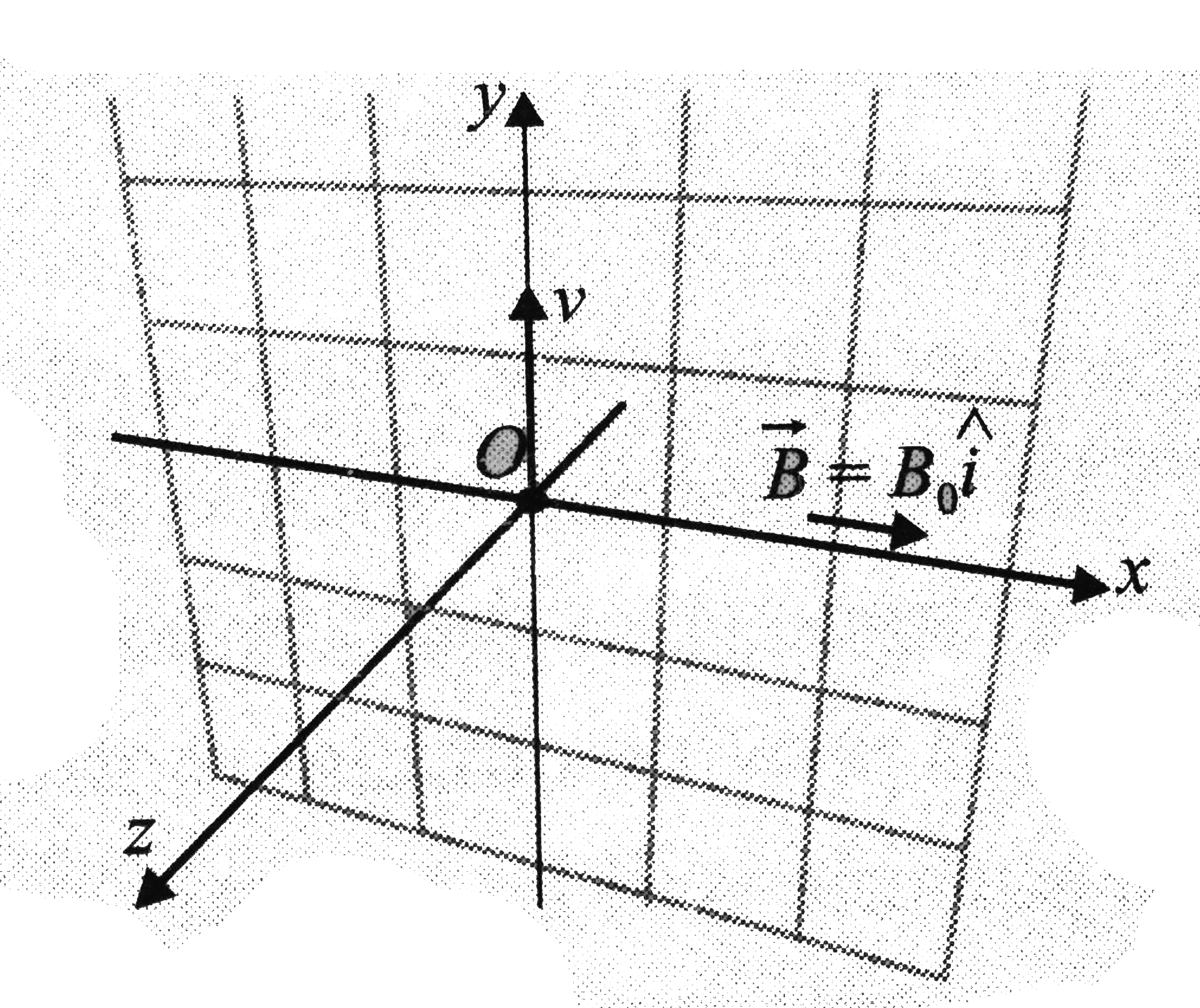In uniform magnetic field, if angle between →vand→Bis0∘<0<90∘, the path of particle is helix. Let v1 be the component of →valong→Bandv2 be the component perpendicular to →B. Suppose p is the pitch. T is the time period and r is the radius of helix. Then
T=2πmqB,r=mv2qB,P=(v1)T
Assume a charged particle of charge q and mass m is released from the origin with velocity →v=v0ˆi−v0ˆk in a uniform magnetic field →B=−B0ˆk.
Axis of helix is along
X-axis
Y-axis
Negative Y-axis
Z-axis
The correct Answer is:D
To solve the problem, we need to analyze the motion of a charged particle in a uniform magnetic field. The key points to consider are the components of the velocity, the magnetic field direction, and the resulting path of the particle.
1. Identify the Components of Velocity:
The velocity vector of the charged particle is given as:
→v=v0^i−v0^k
We can break this down into components:
- The component along the magnetic field, v1, is the component in the direction of ^k.
- The component perpendicular to the magnetic field, v2, is the component in the direction of ^i.
Thus, we have:
v1=−v0(along ^k)
v2=v0(along ^i)
2. Determine the Magnetic Field Direction:
The magnetic field is given as:
→B=−B0^k
This indicates that the magnetic field is directed along the negative z-axis.
3. Identify the Axis of the Helix:
Since the motion of the particle is helical, the axis of the helix will be aligned with the direction of the magnetic field. Given that the magnetic field is along the negative z-axis, the axis of the helix will also be along the z-axis.
4. Conclusion:
Therefore, the axis of the helix is along the direction of the magnetic field, which is:
Axis of helix is along ^k (z-axis).
Final Answer:
The axis of the helix is along the ^k direction (z-axis).
---
The velocity vector of the charged particle is given as:
→v=v0^i−v0^k
We can break this down into components:
- The component along the magnetic field, v1, is the component in the direction of ^k.
- The component perpendicular to the magnetic field, v2, is the component in the direction of ^i.
v1=−v0(along ^k)
v2=v0(along ^i)
The magnetic field is given as:
→B=−B0^k
This indicates that the magnetic field is directed along the negative z-axis.
Since the motion of the particle is helical, the axis of the helix will be aligned with the direction of the magnetic field. Given that the magnetic field is along the negative z-axis, the axis of the helix will also be along the z-axis.
Therefore, the axis of the helix is along the direction of the magnetic field, which is:
Axis of helix is along ^k (z-axis).
The axis of the helix is along the ^k direction (z-axis).
Topper's Solved these Questions
- BOOK - CENGAGE PHYSICS ENGLISHCHAPTER - MISCELLANEOUS VOLUME 5EXERCISE - Integer12videos
MISCELLANEOUS VOLUME 5
- BOOK - CENGAGE PHYSICS ENGLISHCHAPTER - MISCELLANEOUS VOLUME 5EXERCISE - Multiple Correct34videos
MISCELLANEOUS VOLUME 5
- BOOK - CENGAGE PHYSICS ENGLISHCHAPTER - MISCELLANEOUS VOLUME 3EXERCISE - True and False3videos
MISCELLANEOUS VOLUME 3
- BOOK - CENGAGE PHYSICS ENGLISHCHAPTER - NUCLEAR PHYSICSEXERCISE - ddp.5.514videos
NUCLEAR PHYSICS
Similar Questions
In uniform magnetic field, if angle between →vand→Bis0∘<0<90∘, the path of particle is helix. Let v1 be the component of →valong→Bandv2 be the component perpendicular to →B. Suppose p is the pitch. T is the time period and r is the radius of helix. Then
T=2πmqB,r=mv2qB,P=(v1)T
Assume a charged particle of charge q and mass m is released from the origin with velocity →v=v0ˆi−v0ˆk in a uniform magnetic field →B=−B0ˆk.
Angle between v and B isView SolutionIn uniform magnetic field, if angle between →vand→Bis0∘<0<90∘, the path of particle is helix. Let v1 be the component of →valong→Bandv2 be the component perpendicular to →B. Suppose p is the pitch. T is the time period and r is the radius of helix. Then
T=2πmqB,r=mv2qB,P=(v1)T
Assume a charged particle of charge q and mass m is released from the origin with velocity →v=v0ˆi−v0ˆk in a uniform magnetic field →B=−B0ˆk.
Pitch of helical path described by particle isView Solution
Knowledge Check
- Question 1 - Select One
A particle of mass m and charge q has and initial velocity →v=υ0ˆj. If an electric field →E=→–––(0)ˆi and magnetic field →B=B0ˆi act on the particle, its speed will double after a time :
At=2mv0qE0Bt=2B0qmv0Ct=√3B0qmv0Dt=√3mv0qE0
A portion is fired from origin with velocity →v=v0ˆj+v0ˆk in a uniform magnetic field →B=B0ˆj. In the subsequent motion of the proton
View SolutionWrithe the component of →b along →a.
View SolutionWhat is the direction of the force acting on a charged particle q, moving with a velocity →v a uniform magnetic field →B ?
View SolutionA particle of charge q and mass m starts moving from the origin under the action of an electric field →E=E0ˆiand→B=B0ˆi with a velocity →v=v0ˆj. The speed of the particle will become 2v0 after a time.
View SolutionA particle of mass m and charge q has and initial velocity →v=υ0ˆj. If an electric field →E=→–––(0)ˆi and magnetic field →B=B0ˆi act on the particle, its speed will double after a time :
View SolutionA charge particle of mass m and charge q is projected with velocity v along y-axis at t=0.

Find the velocity vector and position vector of the particle →v(t)and→r(t) in relation with time.View SolutionIf a particle is moving as →r=(→i+2→j)cosω0t then,motion of the particleis
View Solution
